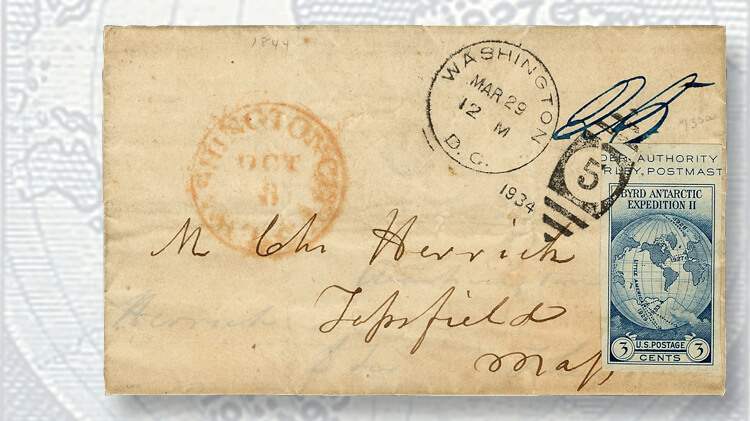US Stamps
Why would an 1844 cover feature a 1934 stamp?

By John M. Hotchner
A combination cover, one from an earlier period to which a newer (and related) stamp has been attached and canceled, does not usually have a 90-year space between its first use and the addition of a new stamp. But the 1844 cover that was featured in this August 2014 U.S. Stamp Notes column is just such a case.
The connection between the 1844 cover, which is canceled in Washington, D.C., and the added 3¢ imperforate margin single from the Byrd Antarctic Expedition souvenir sheet of six (Scott 735), also canceled in Washington, D.C., is not obvious. So, in the aforementioned column, I asked Linn’s readers to weigh in with ideas.
The answer that I think is mostly likely to be the correct one came from Hal Vogel, a scholar in polar philately.
Connect with Linn’s Stamp News:
Sign up for our newsletter
Like us on Facebook
Follow us on Twitter
Vogel said: “The add-on stamp is the imperforate variety of the stamp [issued in February, 1934] to be used primarily on mail from the 1933-35 Byrd Antarctic expedition. It also was acceptable for any valid U.S. postal use, but Antarctic expedition mail was its principal purpose for being.
“There was an earlier exploration just before the time of the 1844 cover. Though officially called the U.S. Exploring Expedition (1838-42), it mostly is known today as the ‘Wilkes Antarctic Expedition.’ It had many significant exploratory achievements, including the discovery of Antarctica as a continent and so naming it (1840).
“Several of the scientists on the Wilkes Antarctic Expedition were in communication with a scientist in New England named E.E. Herrick. Maybe ‘John Herrick,’ the addressee on the 1844 cover, also was involved or was a relative. Possibly in 1934 the defacer of the 1844 cover might have associated the addressee on this stampless mail with the USA’s first Antarctic Expedition and thought it would be neat to tie them together.”
If this is not the answer, we are left with the concept advanced by others that this was a random act of philatelic vandalism by a new collector who didn’t know what he was doing.
MORE RELATED ARTICLES
Headlines
-
US Stamps
Oct 7, 2024, 3 PMMcMurtrie dismissed as APS education director following Sept. 21 arrest
-
US Stamps
Oct 7, 2024, 12 PMVasiliauskas named president of Mystic Stamp Co.
-
US Stamps
Oct 6, 2024, 5 PMApgar souvenir card available
-
US Stamps
Oct 6, 2024, 4 PMFirst Continental Congress and U.N. stamps receive Scott catalog numbers








